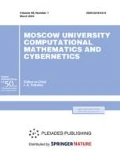Abstract
Two basic methods for recording the activity of neural sources of the human brain are considered: magnetoencephalography (MEG) and electroencephalography (EEG). Homogeneous and spherical models of a head are used. Boundary integral equations for the direct MEG/EEG problem are obtained and analytical solutions of these equations in both cases are presented. The dependence of these solutions on their initial data (the position and the orientation of a source) is shown.
Similar content being viewed by others
References
G. A. Grinberg, Selected Issues of the Mathematical Theory of Electric and Magnetic Phenomena (Akad. Nauk SSSR, Moscow, 1948) [in Russian].
L. D. Landau, E. M. Livshits, and L. P. Pitaevskii, Electrodynamics of Continuous Media (Fizmatlit, Moscow, 2005) [in Russian].
A. M. Popov, “Solution of an EEG inverse problem with the help of stochastic methods of pattern recognition,” Vestn. Mosk. Univ., Ser. 15: Vychisl. Mat. Kibern., No. 3, 91–100 (2006).
M. Hamalainen, R. Hari, R. J. Ilmoniemi, et al., “Magnetoencephalography - theory, instrumentation, and applications to noninvasive studies of the working human brain,” Rev. Mod. Phys. 65, 413–497 (1993).
J. C. Mosher, R. M. Leahy, and P. S. Lewis, “EEG and MEG: Forward solutions for inverse methods,” IEEE Trans. on Biomed. Eng. 46, 245–259 (1999).
V. V. Gnezditskii, Inverse Problem of EEG and Clinical Electroencephalography (Mapping and Locating of the Sources of Electrical Activity of Brain) (MEDPress Inform, Moscow, 2004) [in Russian].
E. V. Zakharov, R. E. Zimozdra, “Limits of applicability of a spherical model for solving Problems of electroencephalography,” Moscow Univ. Comput. Math. Cybernet. 38, 100–104 (2014).
Author information
Authors and Affiliations
Corresponding author
Additional information
Original Russian Text © E.V. Zakharov, R.E. Zimozdra, 2015, published in Vestnik Moskovskogo Universiteta. Vychislitel’naya Matematika i Kibernetika, 2015, No. 2, pp. 11–15.
About this article
Cite this article
Zakharov, E.V., Zimozdra, R.E. Investigating classical models of magneto- and electroencephalography by means of integral equations. MoscowUniv.Comput.Math.Cybern. 39, 58–62 (2015). https://doi.org/10.3103/S0278641915020090
Received:
Published:
Issue Date:
DOI: https://doi.org/10.3103/S0278641915020090



